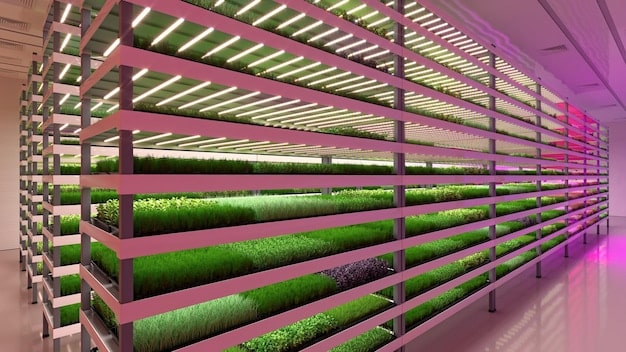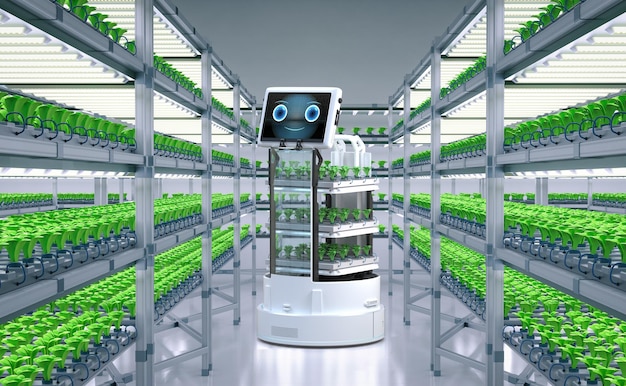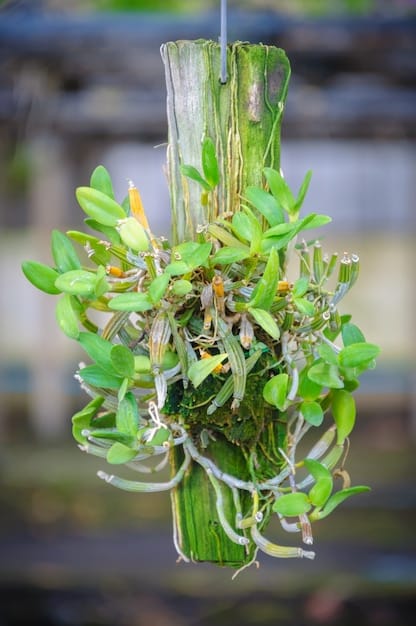Vertical Farming: A Data-Driven Look at US Food Security

Vertical farming presents a promising avenue for enhancing US food security by potentially increasing crop yields and reducing reliance on traditional agriculture, but its economic viability and scalability remain key considerations for widespread adoption.
Is Vertical Farming the Solution to US Food Security? A Data-Driven Analysis of Yields and Costs explores whether this innovative agricultural method can truly address the nation’s food security challenges, considering its potential benefits and economic hurdles.
Understanding US Food Security Challenges
The United States, despite being a major agricultural producer, faces significant food security challenges. These challenges aren’t always about a lack of food production, but also involve accessibility, affordability, and sustainability.
Several factors contribute to these issues, making it crucial to explore innovative solutions like vertical farming.
Key Factors Affecting Food Security
Food security in the US is influenced by a complex interplay of economic, environmental, and social factors. Understanding these drivers is essential for developing effective strategies.
- Climate Change: Increasingly erratic weather patterns, including droughts and floods, threaten crop yields and agricultural stability.
- Economic Inequality: Disparities in income and access to resources limit many Americans’ ability to afford nutritious food.
- Supply Chain Vulnerabilities: Disruptions caused by pandemics, natural disasters, or geopolitical events can severely impact food availability and prices.
- Land Use: Urban sprawl and unsustainable agricultural practices are reducing the availability of arable land for food production.
These factors highlight the need for resilience and innovation in the food system.
In conclusion, addressing US food security requires a multifaceted approach that considers both production and distribution challenges. Vertical farming offers a potential pathway towards a more resilient and sustainable food system, but its feasibility must be carefully evaluated.

What is Vertical Farming?
Vertical farming is an innovative approach to agriculture that involves growing crops in vertically stacked layers, often in a controlled indoor environment. This method maximizes space utilization and enhances resource efficiency.
By controlling factors like temperature, humidity, and lighting, vertical farms can optimize plant growth and minimize environmental impact.
Benefits of Vertical Farming
Vertical farming offers numerous advantages over traditional agriculture, particularly in urban environments.
- Higher Yields: Controlled environments and optimized growing conditions often lead to significantly higher crop yields per square foot compared to conventional farming.
- Reduced Water Usage: Vertical farms can recycle water and use hydroponic or aeroponic systems, reducing water consumption by up to 95%.
- Year-Round Production: Indoor environments allow for continuous crop cycles, regardless of external weather conditions.
- Localized Food Production: Vertical farms can be located in urban areas, reducing transportation costs and carbon emissions associated with food distribution.
These benefits position vertical farming as a potential solution for addressing food security concerns in the US.
In summary, vertical farming represents a transformative approach to food production, offering the potential to increase yields, conserve resources, and enhance food security in urban areas. However, the high initial investment and energy costs remain significant challenges.
Data-Driven Analysis of Crop Yields in Vertical Farms
Understanding the crop yields achieved in vertical farms is crucial for assessing their potential impact on US food security. Data-driven analysis provides valuable insights into the productivity of this innovative agricultural method.
By comparing yields from vertical farms with those from traditional agriculture, we can better understand the potential benefits and limitations of this technology.
Comparing Yields: Vertical Farms vs. Traditional Agriculture
Several studies have compared crop yields in vertical farms with those in traditional agriculture, revealing significant differences.
Vertical farms often achieve significantly higher yields per square foot, particularly for leafy greens like lettuce and spinach. This is due to optimized growing conditions, including controlled temperature, humidity, and lighting.
However, yields can vary depending on the crop type and the specific technologies used in the vertical farm. Some crops, like grains and certain fruits, may be more challenging to grow efficiently in vertical environments.
| Crop | Yield in Vertical Farm (per sq ft) | Yield in Traditional Agriculture (per sq ft) |
|---|---|---|
| Lettuce | 10-20 lbs/year | 1-2 lbs/year |
| Spinach | 15-25 lbs/year | 2-3 lbs/year |
This data highlights the potential of vertical farms to increase crop production, especially for certain types of vegetables.
In conclusion, data-driven analysis confirms that vertical farms can achieve higher crop yields compared to traditional agriculture, particularly for leafy greens. However, optimizing yields for a wider range of crops remains an ongoing challenge.
Examining the Costs Associated with Vertical Farming
While vertical farming offers promising benefits, it also comes with significant costs that need to be carefully examined. Understanding these expenses is crucial for assessing the economic viability and scalability of this agricultural method.
Initial investment, energy consumption, and labor costs are key factors that influence the overall cost-effectiveness of vertical farms.
Key Cost Factors in Vertical Farming
Several factors contribute to the high costs associated with vertical farming.
- Initial Investment: Setting up a vertical farm requires significant capital investment in infrastructure, including buildings, lighting systems, climate control equipment, and hydroponic or aeroponic systems.
- Energy Consumption: Providing artificial lighting and maintaining controlled environmental conditions can lead to high energy consumption, particularly if the farm relies on non-renewable energy sources.
- Labor Costs: While some processes can be automated, vertical farms still require skilled labor for planting, harvesting, and system maintenance.
These costs can be significant barriers to entry for new vertical farms.
Strategies for Reducing Costs
Several strategies can help reduce the costs associated with vertical farming.
- Energy Efficiency: Using energy-efficient LED lighting, optimizing climate control systems, and utilizing renewable energy sources like solar power can significantly reduce energy consumption.
- Automation: Automating tasks like planting, harvesting, and monitoring can reduce labor costs and improve efficiency.
- Government Incentives: Government subsidies and tax breaks can help offset the initial investment costs and encourage the development of vertical farms.
Adopting these strategies can improve the economic viability of vertical farming.
In summary, while vertical farming involves significant costs, strategies like energy efficiency, automation, and government incentives can help reduce these expenses and make vertical farms more economically viable. Further research and development are needed to optimize cost-effectiveness.
The Environmental Impact of Vertical Farming
Vertical farming’s environmental impact is a crucial consideration when evaluating its suitability as a solution for US food security. While it offers potential benefits, it also presents certain challenges.
A comprehensive assessment of energy use, water conservation, and waste management is essential for understanding the overall environmental sustainability of vertical farming.

Positive Environmental Aspects
Vertical farming offers several positive environmental impacts compared to traditional agriculture.
- Reduced Water Consumption: Vertical farms often use hydroponic or aeroponic systems that recycle water, reducing water consumption by up to 95%.
- Lower Carbon Footprint: By locating farms in urban areas, transportation costs and carbon emissions associated with food distribution can be significantly reduced.
- Reduced Pesticide Use: Controlled environments minimize the need for pesticides, reducing environmental pollution.
These benefits make vertical farming an attractive option for environmentally conscious food production.
Potential Environmental Challenges
Despite its benefits, vertical farming also presents certain environmental challenges.
High energy consumption, particularly if the farm relies on non-renewable energy sources, can contribute to greenhouse gas emissions. The production and disposal of materials used in vertical farm construction can also have environmental impacts.
To mitigate these challenges, vertical farms should prioritize energy efficiency, utilize renewable energy sources, and implement sustainable waste management practices.
In conclusion, the environmental impact of vertical farming is a complex issue with both positive and negative aspects. By prioritizing energy efficiency, utilizing renewable energy sources, and implementing sustainable practices, vertical farms can minimize their environmental footprint and contribute to a more sustainable food system.
Can Vertical Farming Truly Ensure US Food Security?
The question of whether vertical farming can truly ensure US food security is complex and requires careful consideration of both its potential and limitations. While vertical farming offers numerous advantages, it is not a panacea.
A holistic approach that combines vertical farming with other sustainable agricultural practices is likely needed to address the multifaceted challenges of food security in the US.
The Potential of Vertical Farming
Vertical farming has the potential to contribute significantly to US food security by increasing crop yields, reducing water consumption, and enhancing localized food production. Its ability to grow crops year-round, regardless of external weather conditions, makes it a resilient and reliable food source.
However, scaling up vertical farming to meet the entire nation’s food needs would require significant investment and technological advancements.
Limitations and Challenges
Several limitations and challenges need to be addressed before vertical farming can fully ensure US food security.
- High Costs: The high initial investment and ongoing energy costs can be barriers to entry for many potential vertical farmers.
- Crop Limitations: Vertical farms are currently best suited for growing leafy greens and certain vegetables. Growing staple crops like grains and corn efficiently in vertical environments remains a challenge.
- Technological Dependence: Vertical farming relies heavily on technology, which can be vulnerable to disruptions and requires ongoing maintenance and upgrades.
Addressing these challenges is crucial for realizing the full potential of vertical farming.
In summary, while vertical farming holds significant promise for enhancing US food security, it is not a standalone solution. A diversified approach that combines vertical farming with other sustainable agricultural practices, such as regenerative agriculture and precision farming, is likely needed to ensure a resilient and secure food system for the nation.
| Key Point | Brief Description |
|---|---|
| 🌱 Higher Yields | Vertical farms often produce higher yields per area compared to traditional farming. |
| 💧 Water Conservation | Vertical farming can significantly reduce water usage through recycling systems. |
| 💸 High Costs | The initial investment and operational costs can be a barrier to entry. |
| 🌍 Environmental Impact | Vertical farms can reduce pesticide use and transportation emissions but require significant energy. |
Frequently Asked Questions (FAQ)
▼
Vertical farming involves growing crops indoors in vertically stacked layers under controlled conditions, optimizing space and resources.
▼
It can enhance food security by increasing crop yields, reducing water usage, and enabling localized, year-round food production in urban areas.
▼
Key challenges include high initial and operational costs, reliance on technology, and the limited range of crops currently suitable for vertical farming.
▼
It can be sustainable if it uses renewable energy, conserves water, and reduces pesticide use, but high energy consumption can be a significant challenge.
▼
Leafy greens like lettuce and spinach, as well as herbs and strawberries, tend to thrive in vertical farms due to their short growth cycles and environmental adaptability.
Conclusion
In conclusion, while vertical farming presents a compelling case for enhancing US food security through increased yields and resource efficiency, its economic and technological challenges must be addressed. A diversified approach, integrating vertical farming with sustainable agricultural practices, is essential for a resilient and secure food system.





